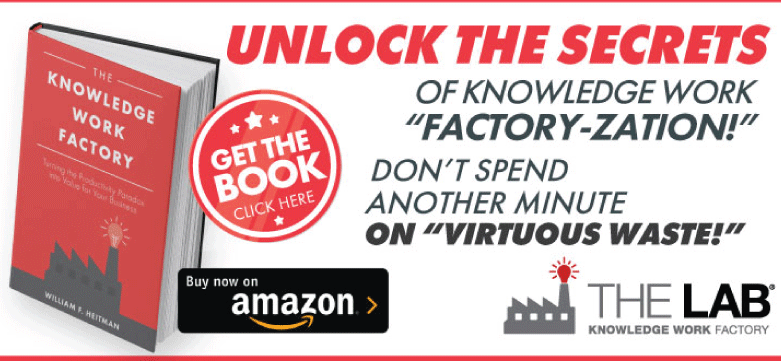You might want to tour your company’s factory, distribution center or even its office furniture management group before you read this.
Not long after the Industrial Revolution arrived, we began to study the making of things.
In Scotland in the 18th Century, Adam Smith studied the making of pins, concluding that specialization of labor would increase the output of pins by a single worker from 20 to 4,800 a day.
Then in the United States in the early 20th Century, Frederick Winslow Taylor took this idea a giant leap further. He discovered that when the design of work tasks is separated from the doing of these tasks, both the design and the doing could be standardized and improved. We can think of this advance as optimizing two parallel factories.
This division created two parallel factories: one to machine the metal, and another, less obvious, to study the machining process and standardize practices, create templates, re-design tools, and come up with countless other productivity aids.
In essence, Taylor took the “how-to” of operating a metal lathe away from skilled machinists, who each used rules of thumb and tribal knowledge as he saw best, and gave the study of this “how-to” to objective observers who spent all of their time methodically looking for better ways to do it.
This division created two parallel factories: one to machine the metal, and another, less obvious, to study the machining process and standardize practices, create templates, re-design tools, and come up with countless other productivity aids. In The Principles of Scientific Management, Taylor emphasized the critical need to physically separate the second factory, writing that it “calls for a room in which to keep the books, records, etc., and a desk for the planner to work at.”
Taylor named this division of activity Scientific Management. Over the next hundred years, from Henry Ford to the Toyota Production System, this basic idea was taken to its Six Sigma limit—5 decimal places—and it delivered breathtaking levels of value in factories and distribution networks. Elsewhere in the organization, however, it has been largely ignored for the past century.
Just as it did in factories, a second dose of Scientific Management would deliver breathtaking levels of value in this knowledge worker population. And it is likely to begin in that most valuable and influential knowledge factory of all — The Finance Group.
No more. The hounds of economic value are sniffing out the untapped potential, which hides in plain sight, in the expanding hordes of knowledge workers. These modern day finance transformation equivalents of Taylor’s steam age machinists each toil with their spreadsheets, using rules of thumb and tribal knowledge handed down to them to measure and increase shareholder value, performing their tasks as each individual sees best. Just as it did in factories, a second dose of Scientific Management would deliver breathtaking levels of value in this finance operations knowledge worker population. And it is likely to begin in that most valuable and influential knowledge factory of all — The Finance Group.
If you are a CFO, your job is to “manufacture value” and transform finance by improving the company’s knowledge about “value manufacturing.” You are that hypothetical planner in Taylor’s Room, hunkered at your desk among the books and records, etc., charged with the task of Scientifically Managing (i.e., increasing) the value of the enterprise.
You are also the plant manager of your own subfactory, its Shop Floor filled with a (likely growing) staff of finance “machinists” who turn out tangible “things” in the form of reports and analysis. Ideally, these should precisely document the company’s knowledge about value production and accurately monitor its progress towards increasing it with finance transformation. Your job is similar to that of any plant manager.
If you are a CFO, your job is to “manufacture value” by improving the company’s knowledge about “value manufacturing.”
A brief tour of your finance group will identify two categories of improvement consistent with the Scientific Management notion of parallel factories: Shop Floor improvements relate to the doing of things. Taylor’s Room improvements involve the design of finance group work tasks and finance transformation. Both of these have flaws with simple, time-tested solutions.
- Plant scheduling is virtually non-existent (Shop Floor). Drop everything, ad hoc requests squander up to 50% of the finance group’s costly and valuable organizational capacity. Simple demand management practices can quickly reduce this to around 15%.
- The product line is out of control (Taylor’s Room). Finance departments generate 2–5 times as many reports as they think they generate, and often up to 10 times as many as users need. Most of these are unused or underused. This problem can be eliminated, along with roughly half of existing reports, by using standard “bills of materials” for report design, report inventories, and basic product management controls.
- Production is inefficient; costs are unknown (Shop Floor). At least 30% of the production activities are rework, error correction and overwork. And the average cost per report ranges from $5,000 to $80,000 annually, but these costs aren’t tracked or questioned. Solve these problems with tools from the 1930s.
- Product performance is poorly evaluated (Taylor’s Room). Many reports are not useful, even counterproductive, for increasing value. Example: The finance group at a Fortune 250 company produces over 10,000 management reports for executives. Less than 6% of these address margins, or profitability. Apply Market Research 101 techniques—now.
Think like a plant manager instead of a CFO and you will see valuable improvements everywhere that will benefit from finance transformation. Notice what your people are doing and how and why. Make fewer, but better finance “things” (reports, analyses) in your finance factory. Make them much more efficiently. Adopt the knowledge management techniques that probably surround you elsewhere in the organization in creating your very own Taylor’s Room for finance. In other words, don’t tolerate in your own shop the kind of activities and attitudes long ago eliminated from your company’s manufacturing and distribution operations.
If you think your business would benefit from lean finance transformation, simply call (201) 526-1200 or email info@thelabconsulting.com to discuss how The Lab can help improve your operations in less than 6 months.

















